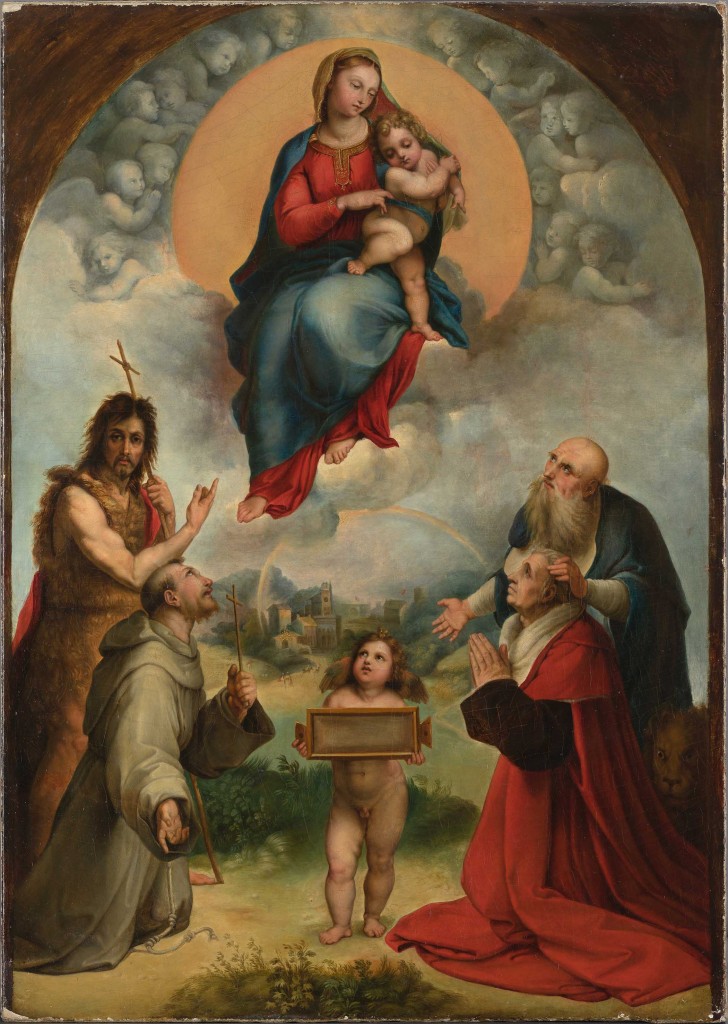A researcher at the University of Granada has successfully attributed to the great Raffaello Sanzio da Urbino, Raphael the famous Renaissance painter, a work belonging to a private collector in Cordoba, Spain. The painting, entitled the ‘Small Madonna of Foligno’, depicts a scene identical to that of the ‘Madonna of Foligno’ and was probably a preliminary version of Raphael’s painting, which is exhibited in the Vatican Pinacoteca.
Luis Rodrigo Rodríguez-Simón, lecturer in the Faculty of Fine Arts at the University of Granada, has identified and reliably attributed the work, hitherto by an unknown artist, following a minutely detailed study lasting several years.
He has conducted a technical, scientific study applying a series of advanced instrumental techniques and analytical methods: X-ray, infrared photography, infrared reflectography, fluorescence under ultraviolet light, analysis of paint layers, scanning electronic microscope linked to an Energy-dispersive X-ray microanalysis system, gas chromatography-mass spectrometry and micro Raman spectroscopy.
As in the Vatican Pinacoteca’s original (320 x 194 cm), the background in the “Small Madonna of Foligno” (93.5 x 66.5 cm) is a landscape. The composition has a heavenly upper plane, where the Virgin appears with the Child, and a lower earthly plane. Here, we find Saint John the Baptist, Saint Francis of Assisi, Saint Jerome, the camerlengo to Pope Julius II, Sigismondo de’ Conti who commissioned the work, and an angel in the centre.
Change of support
The painting arrived in Cordoba from France in the late 19th century. The paint layer study has revealed that the work was transferred from wood to canvas in the second half of the 19th century. A preparation of several layers of lead white over a set of three canvases has been found. This corresponds to the way in which paintings were transferred from one support to another at that time in France. Other paintings by Raphael—‘The Ecstasy of Saint Cecilia’ (Pinacoteca Comunale, Bologna, Italy) and The ‘Madonna of Foligno’ itself (Vatican Pinacoteca)—underwent the same change.
The University of Granada researcher discovered two hidden fragments of paper, stuck to the frame, which confirm that the change of support happened in France. The first is written in French, in iron-gall ink, and gives the date as “16 Avril” and the year, 1888. The other is part of a page from a printed catalogue of works of art to be sold through the “Hotel Drouot” auction house in Paris and dated in 1872.
Raphael’s signature
Using infrared photography, Dr. Rodríguez-Simón identified Raphael’s preliminary sketches for the painting, as well as a combination of different graphic techniques in the underdrawing. “The practice of working with different drawing instruments, ranging from chalk to brush, has been found in many of Raphael’s works”, he says.
Moreover, the study found a direct correspondence between the underdrawing of the Virgin’s head in this painting and a drawing on paper in the British Museum, London, known as “Study for the head of the Virgin”, proving that both were created by the hand of Raphael himself.
In the ‘Small Madonna of Foligno’, two letters decorate the cuff of the Virgin’s tunic: the capital letters “R” and “U”, the initials of Raffaello de Urbino. “Raphael stamped a similar rubric in the decoration that is part of the brocade adorning the same cuff in the major work, held in the Vatican Pinacoteca, with the same theme”, explains Dr. Rodríguez-Simón.
Similarly, he has also discovered the first letters of the name Raffaello or Raphael and the year 1507, which have been incised, when the paint was fresh, in the flesh colour of the Virgin’s right hand.
Infrared photography has also led to another discover of major importance: the existence of numbering on both the upper and right sides and short hairsbreadth lines all around the edge of the painting, some 2.9 cms apart. “These graphics can be explained by the use of the method of squaring to transfer this composition to a larger scale, as shown by the number of squares and the fact that they are so small”, says Dr. Rodríguez-Simón.
Edited article via University of Granada

